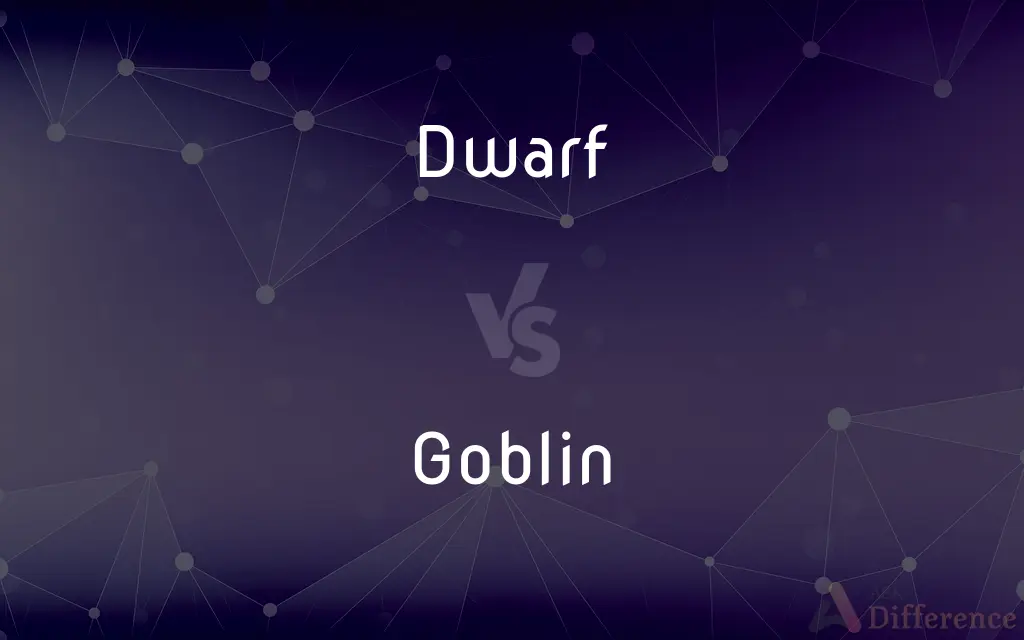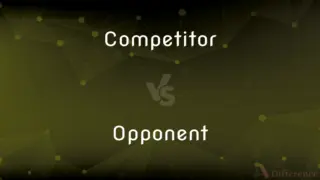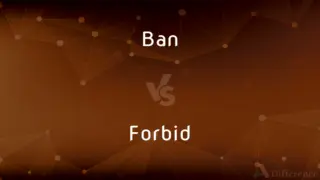Dwarf vs. Goblin — What's the Difference?
By Fiza Rafique & Maham Liaqat — Updated on April 22, 2024
Dwarves are typically depicted as stout, skilled artisans and warriors in folklore, while goblins are often shown as mischievous, weaker creatures that form large groups.

Difference Between Dwarf and Goblin
Table of Contents
ADVERTISEMENT
Key Differences
Dwarves are commonly represented in mythology and fantasy as short, robust, and bearded figures known for their craftsmanship and mining skills. In contrast, goblins are portrayed as smaller, less formidable beings, known for their cunning and often malevolent behavior. Both races are staples in fantasy genres but serve different narrative roles.
Dwarves are usually depicted living in mountains or underground kingdoms, emphasizing their connection with earth and stone. They are often portrayed as master blacksmiths and jewelers. On the other hand, goblins are frequently shown inhabiting dark forests or underground lairs, highlighting their association with more sinister, less civilized environments.
In many stories, dwarves are valorous and loyal, often depicted as honorable warriors in epic battles. Conversely, goblins are typically shown as sneaky and untrustworthy, often serving as minor antagonists that rely on numbers rather than strength or honor in conflict.
Culturally, dwarves are often seen in a positive light, embodying traits like steadfastness, loyalty, and industriousness. Meanwhile, goblins are usually perceived negatively, associated with traits like greed, deceit, and malevolence, reflecting societal views on morality and behavior.
In terms of alliances, dwarves are frequently allies with humans and other noble creatures in mythical tales, reinforcing their status as honorable beings. Goblins, however, are often depicted as allies of darker forces, which underscores their role as mischief-makers and villains in folklore and fantasy settings.
ADVERTISEMENT
Comparison Chart
Physical Build
Short and stout, often depicted as muscular
Smaller, leaner, and less formidable
Living Environment
Mountains or underground cities
Dark forests or underground dens
Skills and Traits
Skilled artisans, honorable and brave
Cunning, deceitful, often malevolent
Cultural Perception
Viewed positively, as industrious and loyal
Often seen negatively, as greedy and sneaky
Typical Alliances
Allies with humans and noble races
Frequently aligned with darker forces
Compare with Definitions
Dwarf
An astronomical term for a star of relatively small size and low luminosity.
A white dwarf is the dense core left after a star has exhausted most of its fuel.
Goblin
In gaming, a common low-level enemy that players often encounter.
Players start by fighting goblins, which are relatively easy to defeat.
Dwarf
A mythical being of short stature, known for strength and craftsmanship.
The dwarf crafted a magnificent sword that was both sturdy and beautiful.
Goblin
A mischievous and ugly creature found in folklore, often causing harm.
The goblin hid in the shadows, waiting for an opportunity to create chaos.
Dwarf
A character type in fantasy literature and games, often a warrior or blacksmith.
In the game, the dwarf character had enhanced abilities in forging weapons.
Goblin
A small, mythical monster generally depicted as green, with a penchant for mischief and trickery.
The green-skinned goblin was always plotting tricks against the villagers.
Dwarf
In folklore, a creature that lives underground and guards treasure.
The dwarves in the mountain guarded their gold with fierce determination.
Goblin
Symbolic of greed and malice in many cultures' stories.
In stories, goblins often embody the dark side of human nature, such as greed and malice.
Dwarf
A derogatory term historically used for a person of unusually short stature.
Historically, the term 'dwarf' was used in a way that is now considered offensive.
Goblin
Occasionally used in a humorous or affectionate context to describe a mischievous child.
Her toddler was such a goblin today, getting into everything!
Dwarf
(in folklore or fantasy literature) a member of a mythical race of short, stocky humanlike creatures who are generally skilled in mining and metalworking.
Goblin
A goblin is a monstrous creature that appears in the folklore of multiple European cultures, first attested in stories from the Middle Ages. They are ascribed various and conflicting abilities, temperaments and appearances depending on the story and country of origin.
Dwarf
A star of relatively small size and low luminosity, including the majority of main sequence stars.
Goblin
A grotesque elfin creature of folklore, thought to work mischief or evil.
Dwarf
Cause to seem small or insignificant in comparison
The buildings surround and dwarf All Saints church
Goblin
One of various hostile supernatural creatures, now especially (fantasy literature) a malevolent and grotesque diminutive humanoid, often associated with orcs or trolls.
Dwarf
A person with a usually genetic disorder resulting in atypically short stature and often disproportionate limbs.
Goblin
An evil or mischievous spirit; a playful or malicious elf; a frightful phantom; a gnome.
To whom the goblin, full of wrath, replied.
Dwarf
An atypically small animal or plant.
Goblin
(folklore) a small grotesque supernatural creature that makes trouble for human beings
Dwarf
A small creature resembling a human, often having magical powers, appearing in legends and fairy tales.
Dwarf
A dwarf star.
Dwarf
To check the natural growth or development of; stunt
"The oaks were dwarfed from lack of moisture" (John Steinbeck).
Dwarf
To cause to appear small by comparison
"Together these two big men dwarfed the tiny Broadway office" (Saul Bellow).
Dwarf
To become stunted or grow smaller.
Dwarf
(mythology) Any member of a race of beings from (especially Scandinavian and other Germanic) folklore, usually depicted as having some sort of supernatural powers and being skilled in crafting and metalworking, often as short with long beards, and sometimes as clashing with elves.
Dwarf
A person of short stature, often one whose limbs are disproportionately small in relation to the body as compared with typical adults, usually as the result of a genetic condition.
Dwarf
An animal, plant or other thing much smaller than the usual of its sort.
Dwarf tree
Dwarf honeysuckle
Dwarf
(star) A star of relatively small size.
Dwarf
Miniature.
The specimen is a very dwarf form of the plant.
It is possible to grow the plants as dwarf as one desires.
Dwarf
(transitive) To render (much) smaller, turn into a dwarf (version).
Dwarf
(transitive) To make appear (much) smaller, puny, tiny.
The newly-built skyscraper dwarfs all older buildings in the downtown skyline.
Dwarf
(transitive) To make appear insignificant.
Bach dwarfs all other composers.
Dwarf
(intransitive) To become (much) smaller.
Dwarf
To hinder from growing to the natural size; to make or keep small; to stunt.
Dwarf
An animal or plant which is much below the ordinary size of its species or kind.
Dwarf
A diminutive human being, small in stature due to a pathological condition which causes a distortion of the proportions of body parts to each other, such as the limbs, torso, and head. A person of unusually small height who has normal body proportions is usually called a midget.
Dwarf
A small, usually misshapen person, typically a man, who may have magical powers; mythical dwarves were often depicted as living underground in caves.
Dwarf
To hinder from growing to the natural size; to make or keep small; to stunt.
Even the most common moral ideas and affections . . . would be stunted and dwarfed, if cut off from a spiritual background.
Dwarf
To become small; to diminish in size.
Strange power of the world that, the moment we enter it, our great conceptions dwarf.
Dwarf
A person who is abnormally small
Dwarf
A legendary creature resembling a tiny old man; lives in the depths of the earth and guards buried treasure
Dwarf
Make appear small by comparison;
This year's debt dwarves that of last year
Dwarf
Check the growth of;
The lack of sunlight dwarfed these pines
Common Curiosities
Can dwarves and goblins be part of the same story?
Yes, both are common in fantasy literature and often appear together, usually as adversaries.
What roles do goblins play in video games?
In video games, goblins are frequently used as low-level antagonists or minor enemies for players to combat.
Are dwarves considered good or evil in most myths?
Dwarves are generally portrayed as good, honorable, and valiant in most myths and stories.
What kind of societies do dwarves form?
Dwarves often form well-organized societies with a strong focus on family and clan loyalty, craftsmanship, and defense.
How are goblins usually portrayed in stories?
Goblins are often depicted as mischievous, malevolent, and weaker creatures who thrive in dark environments.
What makes dwarves distinct from other mythical creatures?
Their combination of crafting skills, physical strength, and a strong sense of honor makes dwarves distinct in mythology.
What is the typical habitat of a dwarf?
Dwarves typically inhabit mountain ranges or underground cities, crafted with their impressive engineering skills.
What are typical characteristics of dwarves in folklore?
Dwarves are typically strong, skilled in crafting, and live in underground or mountainous areas.
How do goblins interact with other mythical creatures?
Goblins often interact as foes or as subordinate allies to more powerful dark creatures in mythical narratives.
Are there any famous goblin characters in popular culture?
Yes, characters like Gollum from J.R.R. Tolkien's works are famous examples of goblins or goblin-like creatures in popular culture.
Do goblins have any redeeming qualities in folklore?
While typically portrayed negatively, some modern interpretations of goblins have shown them to be clever or misunderstood.
What kind of weapons would a dwarf typically use?
Dwarves are often depicted using axes or hammers, reflecting their stout build and smithing skills.
What is a common misconception about goblins?
A common misconception is that all goblins are evil; some stories portray them more neutrally or comically.
Why are goblins often used as enemies in storytelling?
Their traits of deceit and malice make them suitable as common antagonists in various narratives.
How are dwarves depicted in modern media compared to traditional myths?
In modern media, dwarves are often given more depth and variety in character, maintaining their traditional traits while exploring new aspects.
Share Your Discovery

Previous Comparison
Competitor vs. Opponent
Next Comparison
Ban vs. ForbidAuthor Spotlight
Written by
Fiza RafiqueFiza Rafique is a skilled content writer at AskDifference.com, where she meticulously refines and enhances written pieces. Drawing from her vast editorial expertise, Fiza ensures clarity, accuracy, and precision in every article. Passionate about language, she continually seeks to elevate the quality of content for readers worldwide.
Co-written by
Maham Liaqat













































